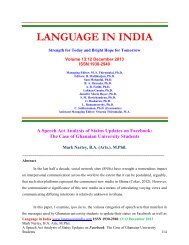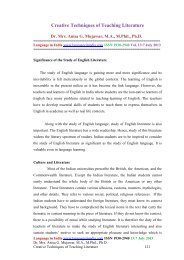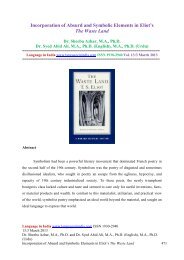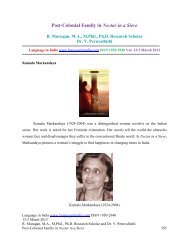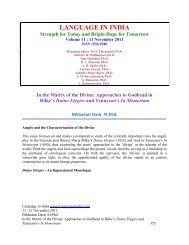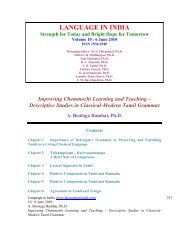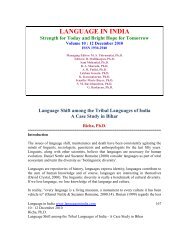LEXICAL OPPOSITES IN TAMIL - Language in India
LEXICAL OPPOSITES IN TAMIL - Language in India
LEXICAL OPPOSITES IN TAMIL - Language in India
You also want an ePaper? Increase the reach of your titles
YUMPU automatically turns print PDFs into web optimized ePapers that Google loves.
LANGUAGE <strong>IN</strong> <strong>IN</strong>DIA<br />
Strength for Today and Bright Hope for Tomorrow<br />
Volume 9 : 12 December 2009<br />
ISSN 1930-2940<br />
Manag<strong>in</strong>g Editor: M. S. Thirumalai, Ph.D.<br />
Editors: B. Mallikarjun, Ph.D.<br />
Sam Mohanlal, Ph.D.<br />
B. A. Sharada, Ph.D.<br />
A. R. Fatihi, Ph.D.<br />
Lakhan Gusa<strong>in</strong>, Ph.D.<br />
K. Karunakaran, Ph.D.<br />
Jennifer Marie Bayer, Ph.D.<br />
Lexical Opposites <strong>in</strong> Tamil<br />
A. Boologa Rambai, Ph.D.<br />
<strong>Language</strong> <strong>in</strong> <strong>India</strong> www.language<strong>in</strong><strong>in</strong>dia.com 112<br />
9 : 12 December 2009<br />
A. Boologa Rambai, Ph.D.<br />
Lexical Opposites <strong>in</strong> Tamil
Introduction<br />
Lexical Opposites <strong>in</strong> Tamil<br />
A. Boologa Rambai, Ph.D.<br />
The study of Tamil Semantics seems to be a neglected field. This may be due to the fact<br />
that semantics is <strong>in</strong> a state of flux and that it has not atta<strong>in</strong>ed the status of rigorous<br />
methodological discipl<strong>in</strong>e, like other major branches of l<strong>in</strong>guistics. As Lyons states <strong>in</strong> his<br />
major work on semantics (1977), there is so much vagueness, ambiguity and confusion<br />
about various concepts <strong>in</strong> semantic studies and, hence, we had to exam<strong>in</strong>e them afresh<br />
and to redef<strong>in</strong>e them.<br />
The present paper takes Lyon‟s treatment of the sense relations of<br />
i) Opposition and Contrast and ii) Directional Orthogonal and Anti Podal Opposition as a<br />
model, I th<strong>in</strong>k that some illustrations given for English by Lyons are equally applicable to<br />
Tamil also.<br />
Lexical Opposites<br />
As <strong>in</strong> other Dravidian languages, <strong>in</strong> Tamil also, vocabulary conta<strong>in</strong>s a large number of<br />
opposites. The standard technical term for “Lexical Opposites”, that is, oppositeness of<br />
mean<strong>in</strong>g between Lexemes is antonymy. The term antonymy was co<strong>in</strong>ed <strong>in</strong> the n<strong>in</strong>eteenth<br />
century to describe oppositeness of mean<strong>in</strong>g which was itself conceived as the opposite<br />
of synonymy.<br />
Antonymy, <strong>in</strong> its broader sense, has often been thought of as referr<strong>in</strong>g to the opposite<br />
extreme from identity of mean<strong>in</strong>g. But this is obviously wrong as when two objects are<br />
compared and contrasted with respect to their possession or lack of some property, this is<br />
done generally on recognition of their similarity <strong>in</strong> other respects. The standard term<br />
antonymy has become as imprecise as the term oppositeness because all k<strong>in</strong>ds of<br />
dichotomization are referred as antonymy.<br />
Lyons (1983:68) suggests that “the fact that antonyms not only have polarity relative to<br />
one another, along the dimension that they constitute, but differ <strong>in</strong> their privilege of<br />
occurrence and <strong>in</strong> the relations that they contract with other lexical items may be thought<br />
of as contribut<strong>in</strong>g to the very def<strong>in</strong>ite sense which we have as native speakers that some<br />
lexical items have a “positive” and others a “negative” r<strong>in</strong>g about them.<br />
B<strong>in</strong>ary opposition is one of the most important pr<strong>in</strong>ciples govern<strong>in</strong>g the structure of<br />
languages. Lyons draws up a workable and convenient classification and this will be the<br />
<strong>Language</strong> <strong>in</strong> <strong>India</strong> www.language<strong>in</strong><strong>in</strong>dia.com 113<br />
9 : 12 December 2009<br />
A. Boologa Rambai, Ph.D.<br />
Lexical Opposites <strong>in</strong> Tamil
asis for the present paper. Oppositeness will be restricted to dichotomous or b<strong>in</strong>ary<br />
contrasts. Antonymy will be restricted still further <strong>in</strong> to gradable opposites. Ungradable<br />
opposites will be termed complementar<strong>in</strong>ess. To be dist<strong>in</strong>guished from both antonymy<br />
and complementarity is converseness.<br />
Lexical Opposites <strong>in</strong> Tamil<br />
Lexical opposites <strong>in</strong> Tamil can be classified as:<br />
Lexical Opposites<br />
Gradable Ungradable<br />
Antonymy Complementarity Converseness Directional<br />
Gradable Lexical Opposites – Antonymy<br />
Orthogonal Anti podal<br />
In Tamil, the gradable opposites reflect the real polarization <strong>in</strong> sense relations. For<br />
example one can ask,<br />
i) <strong>in</strong>ta viiDu anta viiDu poola periyata?<br />
“Is this house as big as that house?”<br />
The fact that one can say<br />
ii) <strong>in</strong>ta viiDu anta viiDu poola periyatu<br />
“This house is as big as that house”<br />
(or)<br />
iii) <strong>in</strong>ta viiDu anta viiTTilum periyatu<br />
“This house is bigger than that house”<br />
Depends upon the grad ability of periyatu.<br />
<strong>Language</strong> <strong>in</strong> <strong>India</strong> www.language<strong>in</strong><strong>in</strong>dia.com 114<br />
9 : 12 December 2009<br />
A. Boologa Rambai, Ph.D.<br />
Lexical Opposites <strong>in</strong> Tamil
The predication of the one implies the predication of the negation of the other; but not<br />
vice versa. The expression<br />
cuuTaana paal “Hot Milk” implies aaraata paal “Not Cold Milk” and<br />
aaR<strong>in</strong>a paal “Cold Milk” implies cuTaata paal “Not Hot Milk” not generally imply<br />
„aaR<strong>in</strong>a paal‟ “Cold Milk”. The traditional logical categories of contraries correspond <strong>in</strong><br />
this oppositeness but it applies more widely.<br />
Grad<strong>in</strong>g (Term given by Sapir) is bound up with the operation of comparison. The<br />
comparison may be explicit, implicit or semi-explicit. Explicit comparison <strong>in</strong>volves two<br />
types of comparison i) two th<strong>in</strong>gs may be compared with respect to a particular „property‟<br />
and this „property‟ predicated of the one <strong>in</strong> a greater degree than it is of the other.<br />
For Example<br />
iv) enkaL viiDu unkaL viiTTilum/viTa periyatu<br />
“Our house is bigger than your house”<br />
ii) two states of the same th<strong>in</strong>g may be compared with respect to the property <strong>in</strong> question.<br />
For Example<br />
v) enkaL viiDu saataaraNamaana viiTTai vita/ilum periyatu<br />
“Our house is bigger than the normal house”<br />
These utterances (without context) may be ambiguous between the two types of<br />
comparison. The substitution of one pair of a gradable antonym for the other and the<br />
transposition of the relevant nom<strong>in</strong>al expression with <strong>in</strong> a comparative sentence results <strong>in</strong><br />
a semantically equivalent sentence.<br />
This grad<strong>in</strong>g may also be implicit and semi-explicitly.<br />
For Example<br />
vi) ennuTaiya aRai periyatu “My Room is big”<br />
We are ascrib<strong>in</strong>g the property or „periyatu‟ “bigness/size” to the referent of our room.<br />
Here the grad<strong>in</strong>g is made implicitly with some norm which is generally understood. We<br />
are implicitly compar<strong>in</strong>g the room with someth<strong>in</strong>g else and assert<strong>in</strong>g that it is bigger.<br />
The standard of comparison may here been explicitly <strong>in</strong>troduced <strong>in</strong> the context where the<br />
sentence is uttered. We say then,<br />
vii) enkaL viiDu periyatu “Our house is big” will usually mean someth<strong>in</strong>g like<br />
<strong>Language</strong> <strong>in</strong> <strong>India</strong> www.language<strong>in</strong><strong>in</strong>dia.com 115<br />
9 : 12 December 2009<br />
A. Boologa Rambai, Ph.D.<br />
Lexical Opposites <strong>in</strong> Tamil
viii) enkaL viiDu cumaaraana viiTTilum periyatu<br />
“Our house is bigger than the ord<strong>in</strong>ary house”<br />
(Or)<br />
ix) enkaL viiDu oru viiTTukkuriya aLaviLum periyatu<br />
“Our house is bigger than the normal house”<br />
Failure to recognize the logical properties of gradable, antonyms can<br />
give rise to a number of pseudo-problems.<br />
By semi-explicitly grad<strong>in</strong>g is meant the use of some comparative<br />
construction without explicit mention of standard of comparison.<br />
For Example<br />
x) ennuTaiya viiDu rompap/mikap periyatu<br />
“My house is very/too big”<br />
is graded semi-explicitly and the standard of comparison will usually have been<br />
previously <strong>in</strong>troduced <strong>in</strong> the context.<br />
Ungradable Lexical Opposites<br />
This type of Lexical Opposites is not possible <strong>in</strong> the comparison.<br />
For Example<br />
aaN “Male” peN “Female”<br />
aaciriyan “Male teacher” aaciriyai “Female Teacher”<br />
and so on. In each pairs “not only the predication of either one of the pair implies the<br />
predication of the negation of other, but also that the predication of the negation of either<br />
implies the predication of the other” (Lyons: 1977:272).<br />
These ungradable lexical opposites can be classified <strong>in</strong> to three types namely i)<br />
Complementarity ii) Converseness and iii) Directional.<br />
Complementarity<br />
It deals with the ungradable opposites. For example aaN “Male”<br />
peN “Female”, a typical pair of ungradable opposites.<br />
For Example<br />
<strong>Language</strong> <strong>in</strong> <strong>India</strong> www.language<strong>in</strong><strong>in</strong>dia.com 116<br />
9 : 12 December 2009<br />
A. Boologa Rambai, Ph.D.<br />
Lexical Opposites <strong>in</strong> Tamil
xi) kaNNan oor aaN “Kannan is a male” implies<br />
kaNNan oru peN illai “Kannan is not a female”<br />
This dichotomization is due to the difference of sex which can be further illustrated from<br />
Tamil usages where both members of a pair are marked for Mascul<strong>in</strong>e and Fem<strong>in</strong><strong>in</strong>e<br />
genders respectively.<br />
For Example<br />
xii) maaNavan “Male Student” maaNavi “Female Student”<br />
xiii) aaciriyan “Male Teacher” aaciriyai “Female Teacher”<br />
Tamil <strong>Language</strong> has no common s<strong>in</strong>gular term to cover each of those pairs. Honorific<br />
s<strong>in</strong>gular form like „maanavar‟ “Student” „aaciriyar‟ “Teacher” can be used when one<br />
does not want to state the sex of the person concerned. In such cases there is a<br />
neutralization of oppositeness. This relationship is also illustrated by the follow<strong>in</strong>g pairs<br />
of words.<br />
For example<br />
xiv) maNamaana “Married” maNamaakaata “Un Married”<br />
xv) uyiuTan iru “Be alive” iRa “To die”<br />
The pair kanni verses maNamaanavaL expresses the complementarity <strong>in</strong> the case of a<br />
woman of marriageable age.<br />
Converseness<br />
Opposition different from antonymy and complementarity is converseness exemplified<br />
by pairs like kaNavan “Husband” manaivi “Wife” which may be regarded as two-place<br />
predicates while Lyons suggests the term converseness for such type of relations. Palmer<br />
(1976:82) po<strong>in</strong>ts out their essential relational characteristics and thus prefers the term<br />
relational opposites.<br />
The comparative forms of explicitly graded antonyms and the correspond<strong>in</strong>g active and<br />
passive forms of transitive verbs operate with<strong>in</strong> the sentences as converses.<br />
For Example<br />
xvi) ravi kaNNanai vita uyaramaanavan<br />
“Ravi is taller than kannan” is the converse of<br />
xvii) kaNnan raviyai viTak kuLLamaanavan<br />
“Kannan is shorter than Ravi”<br />
<strong>Language</strong> <strong>in</strong> <strong>India</strong> www.language<strong>in</strong><strong>in</strong>dia.com 117<br />
9 : 12 December 2009<br />
A. Boologa Rambai, Ph.D.<br />
Lexical Opposites <strong>in</strong> Tamil
xviii) raaman siitaiyai virump<strong>in</strong>aan<br />
“Rama loves sita”<br />
xix) siitai raamanaal virumpappaTTaaL<br />
Sita was loved by Rama”<br />
Provided the appropriate grammatical changes are carried out after the transposition of<br />
the nom<strong>in</strong>al expressions. Pairs of sentence conta<strong>in</strong><strong>in</strong>g converse lexemes or expressions<br />
can be so written that the two members of each pair of sentences will be equivalent.<br />
Converse relations between lexemes which may be used as two place predicative<br />
expressions are especially common <strong>in</strong> areas of the vocabulary hav<strong>in</strong>g to do with<br />
reciprocal social rules.<br />
For Example<br />
xx) maruttuvar/vaittiyar “Doctor” X nooyaaLi “Patient”<br />
xxi) mudalaaLi “Boss” X tozhilaaLi “Servant”<br />
xxii) guru “Teacher” X siiTan “Follower/Student”<br />
xxiii aaNTaan “God” X aTimai “Slave”<br />
The idea of presupposition and expectancy is expressed by some pairs.<br />
For Example<br />
xxiv) v<strong>in</strong>aa “Question” viTai/patil “Answer”<br />
Directional Lexical Opposites<br />
The directional lexical opposites can be further divided <strong>in</strong>to two types as i) Orthogonal<br />
and ii) Antipodal. It is also a major category of lexical opposites. John Lyons (1977:211)<br />
states that “though the directional lexical opposites cannot always be dist<strong>in</strong>guished from<br />
the other three types of lexical opposites, that is, antonymy, complementarity and<br />
converseness is sufficiently important <strong>in</strong> language to be given a separate label”. This type<br />
of opposition is seen most clearly <strong>in</strong> the relationship which holds between<br />
„meelee‟ “Up” „kiizhee‟ “Down”<br />
„vaa‟ “Come” „poo‟ “Go”<br />
„vantatu‟ “arrived it” „puRappaTTatu‟ “Departure it”<br />
„iTa‟ “Left” „vala‟ “Right”<br />
„munnaal‟ “Front” „p<strong>in</strong>naal‟ “Beh<strong>in</strong>d”<br />
<strong>Language</strong> <strong>in</strong> <strong>India</strong> www.language<strong>in</strong><strong>in</strong>dia.com 118<br />
9 : 12 December 2009<br />
A. Boologa Rambai, Ph.D.<br />
Lexical Opposites <strong>in</strong> Tamil
The directionality of „meelee‟ X kiizhee <strong>in</strong> the vertical dimension is absolute <strong>in</strong> a way<br />
that the directionality of „iTam‟ X „valam‟ and „mun‟ X „p<strong>in</strong>‟ is not absolute.<br />
Orthogonal<br />
The oppositions which holes with <strong>in</strong> the set „vaTakku‟ “North” „teRkku‟ “South”<br />
„kizhakku‟ “East” „meeRkku‟ “West” each of the four members of the set is opposed <strong>in</strong><br />
this way to „kizhakku‟ and „meeRkku‟; „kizhakku is opposed to „teRkku‟ and „vaTakku‟.<br />
Antipodal Oppositions<br />
This opposition which holds with <strong>in</strong> the set, that is, <strong>in</strong> the four directions, is to be opposed<br />
to one another. „vaTakku‟ is thus opposed to „teRkku‟ and „kizhakku‟ is opposed to<br />
„meeRkku‟.<br />
The antipodal oppositions are dom<strong>in</strong>ant than the orthogonal oppositions. In Tamil<br />
„vaTakku‟ X „teRkku‟ and „kizhakku‟ X „meeRkku‟ are opposites rather than „vaTakku‟<br />
and „kizhakku‟ or „teRkku‟ and „meeRkku‟. This opposition also seems to operate to<br />
some extent <strong>in</strong> the area of colour. John Lyons (1977:286) neither concludes “nor is the<br />
dist<strong>in</strong>ction between orthogonal and antipodal opposition always as clear <strong>in</strong> the<br />
vocabulary as might appear to be the case”.<br />
Unlike <strong>in</strong> English, opposites <strong>in</strong> Tamil are usually expressed by suffixes. Loan words<br />
opposites are usually expressed by native prefixes.<br />
For Example<br />
xxv) „dharmaa‟ “Justice” X „adharmaa‟ “In justice”<br />
„niithi‟ “Justice” X „aniithi‟ “In justice”<br />
„niyaayam‟ “Justice X „aniyaayam‟ “In justice”<br />
Lexical opposites <strong>in</strong> Tamil may be morphologically related or unrelated irrespective of<br />
the fact that whether they are gradable or ungradable.<br />
As <strong>in</strong> English and many other languages the most commonly used opposites <strong>in</strong> Tamil<br />
tend to be morphologically unrelated.<br />
Fro Example<br />
xxvi) „nalla‟ “Good” X „keTTa‟ “Bad”<br />
„uyaram‟ “Tall/height” X „taazhvu‟ “Low”<br />
„azhaku‟ “Beautiful” X „avalaTshaNam‟ “Ugly”<br />
„mutiya‟ “Old” X „iLaiya‟ “Young”<br />
„vanmai‟ “Hardness” X „menmai‟ “Softness”<br />
<strong>Language</strong> <strong>in</strong> <strong>India</strong> www.language<strong>in</strong><strong>in</strong>dia.com 119<br />
9 : 12 December 2009<br />
A. Boologa Rambai, Ph.D.<br />
Lexical Opposites <strong>in</strong> Tamil
„tuuram‟ “Distance” X „kiTTa‟ “Near”<br />
Morphologically Related Opposites<br />
In the case of morphologically related opposites the base form of one member of the pair<br />
is derived from the base form of the other by substitut<strong>in</strong>g the negative suffix.<br />
For Example<br />
xxvii) „aRivuTaiyaar‟ “Knowledgeable people”<br />
X<br />
„aRivilaar‟ “Knowledge less people”<br />
„maNamaana‟ “Married”<br />
X<br />
„maNamaakaata‟ “Un married”<br />
„naTppaana‟ “Friendly”<br />
X<br />
„naTppillaata‟ “Un friendly”<br />
Morphologically Reduplicative Unrelated Pairs<br />
Private Opposition<br />
„aTikkaTi‟ “Frequently” „iTaiiTai‟ “Not frequently”<br />
„UTanukkuTan‟ “At once” „mellamella‟ “Slowly”<br />
A privative opposition is a contrastive relation between two lexemes one of which<br />
denotes some positive property and the other of which denotes the absence of their<br />
property.<br />
For Example<br />
xxviii) „uyiruLLa‟ “With Life” „uyirillaata‟ “Without life”<br />
„acaiyum‟ “Movable” „acaivillaata‟ “Immovable”<br />
<strong>Language</strong> <strong>in</strong> <strong>India</strong> www.language<strong>in</strong><strong>in</strong>dia.com 120<br />
9 : 12 December 2009<br />
A. Boologa Rambai, Ph.D.<br />
Lexical Opposites <strong>in</strong> Tamil
Equipollent Opposition<br />
An equipollent opposition is a relation <strong>in</strong> which each of the contrast<strong>in</strong>g lexemes denotes a<br />
positive property.<br />
For Example<br />
xxix) „aaN‟ “Male” X „peN‟ “Female”<br />
Conclusion<br />
1. In Tamil the gradable opposites, that is, the antonymy is possible.<br />
2. Grad<strong>in</strong>g is possible <strong>in</strong> Tamil by explicitly, implicitly and semi-explicitly.<br />
3. Ungradable Lexical Opposite is not possible <strong>in</strong> the comparison.<br />
4. Ungradable opposites other than comparison, that is, the complementarity,<br />
Converseness and Directional are possible <strong>in</strong> Tamil.<br />
5. The two types of Directional opposites, that is, the orthogonal and the<br />
antipodal are possible <strong>in</strong> Tamil.<br />
6. Morphologically related opposites, morphologically reduplicated unrelated<br />
opposites, private and equipollent opposition are possible <strong>in</strong> Tamil. In Tamil<br />
the opposites are suffixed to the words.<br />
References<br />
1. Lyons, John 1963 Structural Semantics An analysis of part of<br />
vocabulary of Plato, Oxford: For the Society<br />
by Basil Block Well, pp: 61-69.<br />
2. ________ 1968 Introduction to Theoretical L<strong>in</strong>guistics, London<br />
New York & Melbourne: Cambridge<br />
University Press, pp: 460-476.<br />
3. _________ 1977 Semantics Vol. I & II Chapter 9, London, New<br />
York & Melbourne, Cambridge University<br />
Press, pp: 270-335.<br />
4. Sapir, Edward 1944 On Grad<strong>in</strong>g: A Study <strong>in</strong> Semantics, Philosophy<br />
<strong>in</strong> Science 2 pp: 93-116, Repr<strong>in</strong>ted <strong>in</strong> Sapir<br />
1949.<br />
<strong>Language</strong> <strong>in</strong> <strong>India</strong> www.language<strong>in</strong><strong>in</strong>dia.com 121<br />
9 : 12 December 2009<br />
A. Boologa Rambai, Ph.D.<br />
Lexical Opposites <strong>in</strong> Tamil
5. __________ 1949 Selected Writ<strong>in</strong>g <strong>in</strong> <strong>Language</strong> Culture and<br />
Personality, Edited by D.G.Mandalbaum,<br />
Berkley University of California Press.<br />
A. Boologarambai, Ph.D.<br />
Department of Tamil <strong>Language</strong> and Translation Studies<br />
Dravidian University<br />
Kuppam – 517 425<br />
Andhra Pradesh, <strong>India</strong><br />
arpudharambai@gmail.com<br />
<strong>Language</strong> <strong>in</strong> <strong>India</strong> www.language<strong>in</strong><strong>in</strong>dia.com 122<br />
9 : 12 December 2009<br />
A. Boologa Rambai, Ph.D.<br />
Lexical Opposites <strong>in</strong> Tamil



